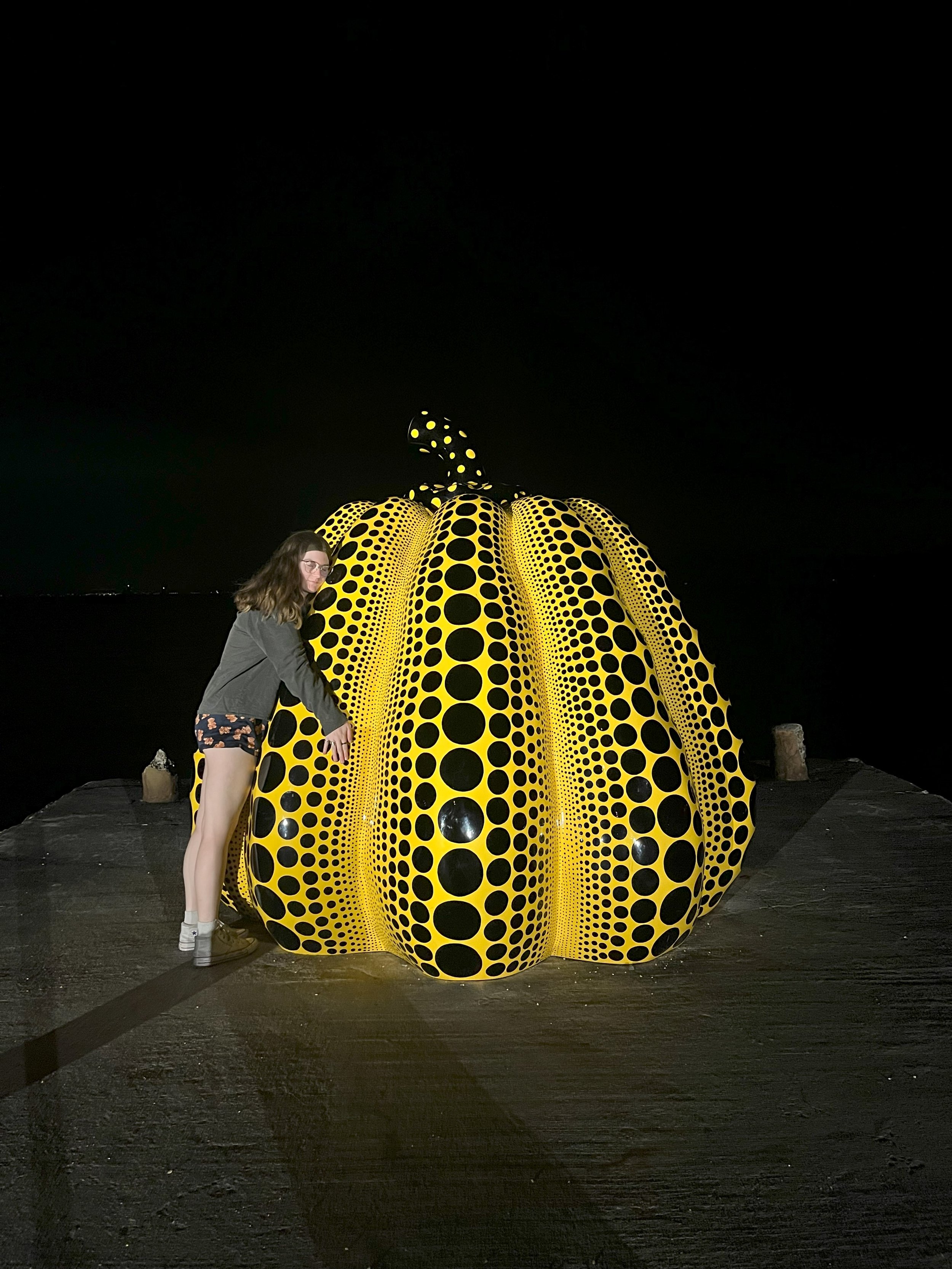Art on Naoshima Island
One of the major characteristics of Naoshima is the numerous sculptural works and art sites which are spread out across the island’s ports, shore and village. This is what makes Naoshima known as the Japanese Art Island, known for its art adapting to the terrain of the island.
Some of the most notable works which can be seen on the island are the Pumpkin sculptures made by Yayoi Kusama, one of the most distinctive and recognisable contemporary artists originating from Japan. The first pumpkin on the island is the large red pumpkin, which is the first thing that can be seen upon arriving to Naoshima Island; as it is located right next to Naoshima’s port.
for some silly reason I didn’t get a picture of the red pumpkin just by itself- so here’s the group photo!
I really like the red pumpkin as it is a little bit interactive; there are little peepholes where you can step inside and pose for pictures, and it is much bigger in scale which creates a cool visual effect for photos! I was mainly fascinated by its plump shape, as it is quite wide and circular; I further explored this through making pumpkin sketches in my sketchbook of varying sizes and proportions. Most importantly, I feel as if this great big red pumpkin sets the tone upon arriving to Naoshima Island; cheerful, bright and a little bit of fun!
The other pumpkin located on the island is a yellow pumpkin located on the pier of the beach, just further up from the Benesse House. It is a slimmer, taller pumpkin which is much smaller in scale (still much larger than us though!). This pumpkin lacks any peepholes but has a much more interesting pattern consisting of varying scales of circles; which creates more contrast. One little interesting fact about this pumpkin was how it got washed away from a Typhoon about three years ago; honestly hearing this I found it a little bit humourous, mainly due to the vision of seeing a large yellow pumpkin on the ocean is a little bit strange. However, I loved how close this pumpkin was to our yurt accommodation, as I visited it after dark on a beach walk and was absolutely in awe with how beautiful it looks in the dark!
A picture of the yellow pumpkin I took on my little digital camera- this ended up being one of my favourite photos!
here’s the yellow pumpkin at night time- I had to give it a little bit of love!
this is honestly a really bad photo but you get the idea- the pumpkin is absolutely stunning to view at night!
In addition to Kusama’s iconic pumpkins, there are some other fun sculptural works which surround the Benesse House. These are brightly coloured, abstracted sculptures of animals and people, created by artists such as Karel Appel and Niki de Saint Phalle. My personal favourites are Niki de Saint Phalle’s Frog and Cat (1990) and Le Banc (1989), both of which are playful, flamboyant sculptures which greatly contrast against the natural environment.
Niki de Saint Phalle’s Frog and Cat (1990), the largest sculpture in the gardens surrounding the Benesse House which greets you as you approach the Museum.
Niki de Saint Phalle’s Le Banc (1989); I really liked the placement of this one, right outside of the Museum’s gift shop; its as if the man is waiting for someone!
These sculptural works only made up a small section of the art available on the island, though I personally find myself attracted to them due to the positive, playful atmosphere that they generate; paralleling the spirit of Naoshima Island. Despite these works being so drastically different to what I am usually attracted to in my practice, I am intrigued by their uplifting energy; if anything they have demonstrated how large, flamboyant abstract sculptures can weirdly complement and work with the natural environment. It was really cool being able to see Yayoi Kusama’s work in person; as I distinctively remember Kusama’s designs from my childhood. I’ve heard that Kusama will have a solo exhibition at the NGV in Melbourne at the end of the year, so I am super excited to see how their works appear at home in comparison to what I’ve seen in Naoshima!





